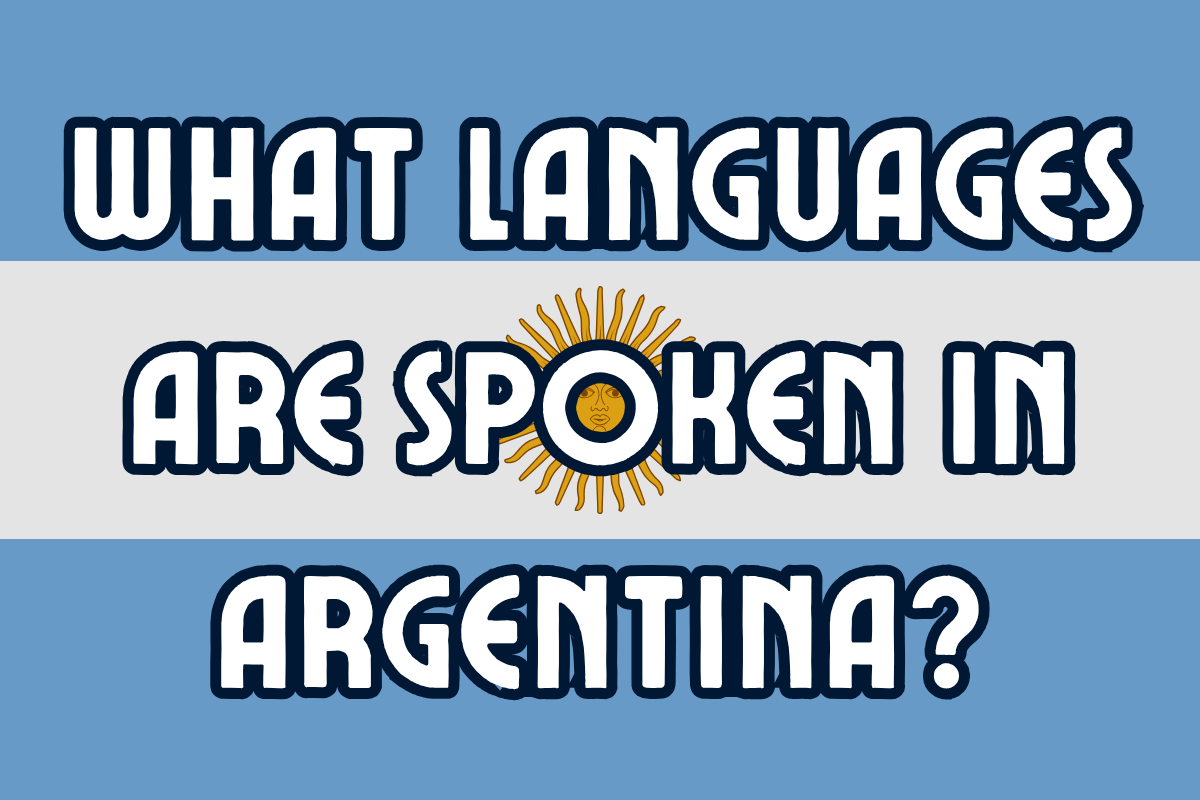The most common language spoken in Argentina is Spanish, with nearly all Argentinians speaking it as a first or second language. Over one million people speak at least one of the fifteen tribal languages of Argentina. Other foreign languages were imported during and after the colonization of South America and are spoken widely in their respective ethnic communities.
Argentina is a key player in the South American region. Ever since the Spanish colonized the country back in 1536, Argentina has been developing as visitors poured in from cultures afar.
At the turn of the 20th century, Argentina was the seventh-wealthiest nation in the world following an especially large influx of immigrants.
Spanish is well-established as the dominant language in the entire region, but other languages have also had a big impact on the country.

How many people speak Spanish in Argentina?
As the de-facto official language of Argentina, Spanish is used in all areas of life.
Everything from media to politics uses Spanish to communicate, so it’s important to have at least a good grasp of the language if you want to live in the country.
Of Argentina’s 43.8 million current population, 41.7 million speak Spanish as their first language and another million speak it as a second language.
This means that a staggering 97.5% of the Argentinian population speaks Spanish.
Argentine Spanish isn’t exactly the same as the original Spanish from Spain.
Centuries of mixture with other languages have affected the pronunciation, grammar, and slang of Argentine Spanish.
Close to Argentina’s border with Brazil, many people speak Portuñol, a pidgin of Spanish and Portuguese.
This is because Brazil is the only country in South America other than Uruguay that has Portuguese as its official language.
Which native languages are spoken in Argentina?
Before Spanish colonizers arrived, there were many tribes living in the River Plate area of South America.
In total, there were 38 different native languages spoken in the borders of what is now Argentina, of which 20 are now extinct.
There are 1.2 million indigenous language speakers in Argentina, but their numbers are declining rapidly.
Most languages that aren’t already extinct have become endangered.
Native Argentinian languages are classified into the following language families:
- Aymaran languages. A small family of only three languages found in the Central Andes. Only one, Aymara, is spoken in Argentina.
- Arawakan languages. Arawakan is one of the largest language families in the Americas, spanning across South America, Central America, and the Caribbean. The language of Chané used to be spoken in Argentina’s Salta province but is now extinct. Most Chané people now speak Guarani or Spanish.
- Charruan languages. Little is known about these languages. They are believed to have become mostly extinct in the early 20th century, with only a single native Chaná speaker found in 2005.
- Chonan languages. These languages are mostly extinct, with less than 10 speakers of the only living language, Tehuelche, left.
- Huarpean languages. A family of two dialects that became extinct in the 18th
- Mataco-Guaicuru languages. Spoken in Argentina, Brazil, Paraguay, and Bolivia, this language family is not well defined as many linguists differ over which languages to include and exclude from it.
- Quechuan languages. This family includes Quecha, the second-most widely spoken native language in Argentina with 65,000 speakers (over 800,000 in all countries).
- Tupian languages. Originally from the Amazon Basin, speakers of these languages migrated down to Argentina. In the Tupian family is the Guarani language group, which is the most common native language in Argentina today with over 200,000 speakers.
- Isolated languages. These languages don’t fit into any language families. Kunza, Mapuche, Puelche, and Yaghan fall into this category, and all of them are extinct except for Mapuche.
- Unclassified languages. Rare documentation and references speak of these languages, although not enough information is available to classify them.
None of these native languages are officially recognized in Argentina except in the provinces of Chaco and Corrientes.
Chaco declared Kom, Moqoit, and Wichí and Corrientes declared Guaraní official alongside Spanish.
Which foreign languages are spoken in Argentina?
Argentina is a language of many nations, with immigrants coming into the country in their millions over the centuries.
The late 19th until early 20th century saw over 4 million immigrants enter the country, many from Italy and surrounding countries in Europe.
Common foreign languages in Argentina are:
- Over 1.5 million Argentinians natively speak Italian, making it the most common foreign language in Argentina by far. It’s unclear why so many Italians chose to immigrate to Argentina, but it has certainly left a mark on the country. Over 60% of the Argentinian population has at least part Italian ancestry. Many of the pronunciation and grammar differences between Argentine Spanish and the original Spanish can be attributed to Italian influence.
- The Arabic dialect spoken in Argentina, called Levantine Arabic, originated from the eastern Mediterranean coast. Over 1 million native Levantine Arabic speakers currently live in Argentina, most having fled their home countries during the Mount Lebanon civil war in Lebanon and Syria.
- The most common dialect of German in Argentina is Plautdietsch with nearly 400,000 speakers. Plautdietsch is spoken widely in the Mennonite communities and other clusters of German descendants across the country. It is believed that many Germans who fled Germany during World War 2 chose Argentina as a safe refuge.
- Argentina has the seventh-largest Jewish community in the world and the largest in South America. Around 200,000 Jews call Argentina their home, with more or less the same amount of Yiddish speakers in the country.
- Catalan is a dialect of Spanish spoken in Catalonia, Spain. During the 20th century, many Catalans immigrated to other countries in voluntary exile. Over 174,000 Catalan speakers reside in Argentina today.
Argentina, heavily influenced by the world outside its borders and to a lesser extent by the native cultures, is much more than just another Latin American country.
Yes, most people in Argentina do speak Spanish, but there’s a lot more to the story and many other languages involved.
With over 40 common languages spoken across the country, linguists are certainly spoiled for choice.
Thankfully, you’ll only need to learn Spanish if you ever decide to visit.
More in Regional Languages
- What Languages Are Spoken In Afghanistan?
- What Languages Are Spoken In Africa?
- What Languages Are Spoken In Albania?
- What Languages Are Spoken In America?
- What Languages Are Spoken In Antwerp?
- What Languages Are Spoken In Argentina?
- What Languages Are Spoken In Australia?
- What Languages Are Spoken In Austria?
- What Languages Are Spoken In Bangladesh?
- What Languages Are Spoken In Barcelona?
- What Languages Are Spoken In Belgium?
- What Languages Are Spoken In Bolivia?
- What Languages Are Spoken In Bosnia?
- What Languages Are Spoken In Brazil?
- What Languages Are Spoken In Budapest?
- What Languages Are Spoken In China?
- What Languages Are Spoken In Colombia?
- What Languages Are Spoken In Croatia?
- What Languages Are Spoken In Cuba?
- What Languages Are Spoken In Cyprus?
- What Languages Are Spoken In Denmark?
- What Languages Are Spoken In Djibouti?
- What Languages Are Spoken In Ecuador?
- What Languages Are Spoken In Egypt?
- What Languages Are Spoken In El Salvador?
- What Languages Are Spoken In England?
- What Languages Are Spoken In Eritrea?
- What Languages Are Spoken In Estonia?
- What Languages Are Spoken In Ethiopia?
- What Languages Are Spoken In Fiji?
- What Languages Are Spoken In Finland?
- What Languages Are Spoken In Germany?
- What Languages Are Spoken In Japan?
- What Languages Are Spoken In Morocco?
- What Languages Are Spoken In South Africa?

